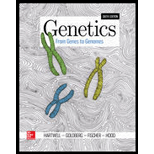
Concept explainers
Canavan disease, caused by homozygosity for a recessive allele, is a severe neurodegenerative syndrome usually resulting in death by the age of 18 months. The frequency of Canavan disease is particularly high in Jewish populations. In an effort to map the gene causing this condition, researchers looked at 10 SNPs (1–10) spaced at roughly 100 kb distances along chromosome 17 in five affected Jewish patients (Cases) and four unaffected Jewish individuals (Controls). In the accompanying table, each row depicts a single haplotype. (Every individual is diploid and therefore has two haplotypes, although only one is shown in the table.) G, C, A, and T represent the actual
| Case | SNP1 | SNP2 | SNP3 | SNP4 | SNP5 | SNP6 | SNP7 | SNP8 | SNP9 | SNP10 |
| 1 | G | T | G | T | T | T | C | A | G | T |
| 2 | A | T | G | T | T | T | C | A | G | T |
| 3 | G | T | G | T | T | T | C | A | G | C |
| 4 | A | A | G | T | T | T | C | T | C | C |
| 5 | G | A | G | C | C | T | G | A | C | C |
| Control | ||||||||||
| 6 | A | A | G | T | T | T | C | A | G | T |
| 7 | G | T | G | G | C | T | G | A | G | T |
| 8 | A | T | C | T | C | G | C | T | C | C |
| 9 | G | T | C | G | T | G | G | A | C | T |
| a. | Does the disease-causing mutation appear to be in linkage disequilibrium with any of the SNP alleles? If so, which ones? |
| b. | Where is the most likely location for the Canavan disease gene? About how long is the region to which you can ascribe the gene? |
| c. | How many independent mutations of the Canavan gene are suggested by these data? |
| d. | Suppose that individuals 2–9 are Ashkenazic (whose ancestors lived in the Rhine river basin of Germany and France after the Jews were expelled from Judea in 70 A.D.) while individual 1 is Sephardic (a non-Ashkenazic Jew). Would these facts provide any information about the history of the mutations causing Canavan disease? |
| e. | For mapping genes by haplotype association, why is it often helpful to focus on certain subpopulations? Does this strategy have any disadvantages? |
| f. | Human chromosome 17 is an autosome, so each person has two copies of each region along the chromosome. With this in mind, explain the practical difficulty in determining haplotypes. (Hint: Consider heterozygosity.) In light of this difficulty, how could the researchers determine any individual haplotype, such as any of those shown in the table? |
Want to see the full answer?
Check out a sample textbook solution
Chapter 22 Solutions
Genetics: From Genes To Genomes (6th International Edition)
- 18. Watch this short youtube video about SARS CoV-2 replication. SARS-CoV-2 Life Cycle (Summer 2020) - YouTube.19. What is the name of the receptor that SARS CoV-2 uses to enter cells? Which human cells express this receptor? 20. Name a few of the proteins that the SARS CoV-2 mRNA codes for. 21. What is the role of the golgi apparatus related to SARS CoV-2arrow_forwardState the five functions of Globular Proteins, and give an example of a protein for each function.arrow_forwardDiagram of check cell under low power and high powerarrow_forward
- a couple in which the father has the a blood type and the mother has the o blood type produce an offspring with the o blood type, how does this happen? how could two functionally O parents produce an offspring that has the a blood type?arrow_forwardWhat is the opening indicated by the pointer? (leaf x.s.) stomate guard cell lenticel intercellular space none of thesearrow_forwardIdentify the indicated tissue? (stem x.s.) parenchyma collenchyma sclerenchyma ○ xylem ○ phloem none of thesearrow_forward
- Where did this structure originate from? (Salix branch root) epidermis cortex endodermis pericycle vascular cylinderarrow_forwardIdentify the indicated tissue. (Tilia stem x.s.) parenchyma collenchyma sclerenchyma xylem phloem none of thesearrow_forwardIdentify the indicated structure. (Cucurbita stem l.s.) pit lenticel stomate tendril none of thesearrow_forward
- Identify the specific cell? (Zebrina leaf peel) vessel element sieve element companion cell tracheid guard cell subsidiary cell none of thesearrow_forwardWhat type of cells flank the opening on either side? (leaf x.s.) vessel elements sieve elements companion cells tracheids guard cells none of thesearrow_forwardWhat specific cell is indicated. (Cucurbita stem I.s.) vessel element sieve element O companion cell tracheid guard cell none of thesearrow_forward
 Human Heredity: Principles and Issues (MindTap Co...BiologyISBN:9781305251052Author:Michael CummingsPublisher:Cengage Learning
Human Heredity: Principles and Issues (MindTap Co...BiologyISBN:9781305251052Author:Michael CummingsPublisher:Cengage Learning Biology (MindTap Course List)BiologyISBN:9781337392938Author:Eldra Solomon, Charles Martin, Diana W. Martin, Linda R. BergPublisher:Cengage Learning
Biology (MindTap Course List)BiologyISBN:9781337392938Author:Eldra Solomon, Charles Martin, Diana W. Martin, Linda R. BergPublisher:Cengage Learning Human Biology (MindTap Course List)BiologyISBN:9781305112100Author:Cecie Starr, Beverly McMillanPublisher:Cengage Learning
Human Biology (MindTap Course List)BiologyISBN:9781305112100Author:Cecie Starr, Beverly McMillanPublisher:Cengage Learning Principles Of Radiographic Imaging: An Art And A ...Health & NutritionISBN:9781337711067Author:Richard R. Carlton, Arlene M. Adler, Vesna BalacPublisher:Cengage Learning
Principles Of Radiographic Imaging: An Art And A ...Health & NutritionISBN:9781337711067Author:Richard R. Carlton, Arlene M. Adler, Vesna BalacPublisher:Cengage Learning Biology: The Dynamic Science (MindTap Course List)BiologyISBN:9781305389892Author:Peter J. Russell, Paul E. Hertz, Beverly McMillanPublisher:Cengage Learning
Biology: The Dynamic Science (MindTap Course List)BiologyISBN:9781305389892Author:Peter J. Russell, Paul E. Hertz, Beverly McMillanPublisher:Cengage Learning





